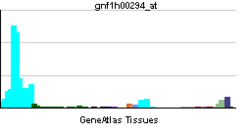- PAG1
-
Phosphoprotein associated with glycosphingolipid-enriched microdomains 1 is a protein that in humans is encoded by the PAG1 gene.[1][2]
The protein encoded by this gene is a type III transmembrane adaptor protein that binds to the tyrosine kinase csk protein. It is thought to be involved in the regulation of T cell activation.[2]
Interactions
PAG1 has been shown to interact with FYN,[1] C-src tyrosine kinase,[1] Sodium-hydrogen antiporter 3 regulator 1[3] and Abl gene.[4]
References
- ^ a b c Brdicka T, Pavlistova D, Leo A, Bruyns E, Korinek V, Angelisova P, Scherer J, Shevchenko A, Hilgert I, Cerny J, Drbal K, Kuramitsu Y, Kornacker B, Horejsi V, Schraven B (May 2000). "Phosphoprotein associated with glycosphingolipid-enriched microdomains (PAG), a novel ubiquitously expressed transmembrane adaptor protein, binds the protein tyrosine kinase csk and is involved in regulation of T cell activation". J Exp Med 191 (9): 1591–604. doi:10.1084/jem.191.9.1591. PMC 2213442. PMID 10790433. http://www.pubmedcentral.nih.gov/articlerender.fcgi?tool=pmcentrez&artid=2213442.
- ^ a b "Entrez Gene: PAG1 phosphoprotein associated with glycosphingolipid microdomains 1". http://www.ncbi.nlm.nih.gov/sites/entrez?Db=gene&Cmd=ShowDetailView&TermToSearch=55824.
- ^ Brdicková, N; Brdicka T, Andera L, Spicka J, Angelisová P, Milgram S L, Horejsí V (Oct. 2001). "Interaction between two adapter proteins, PAG and EBP50: a possible link between membrane rafts and actin cytoskeleton". FEBS Lett. (Netherlands) 507 (2): 133–6. doi:10.1016/S0014-5793(01)02955-6. ISSN 0014-5793. PMID 11684085.
- ^ Wen, S T; Van Etten R A (Oct. 1997). "The PAG gene product, a stress-induced protein with antioxidant properties, is an Abl SH3-binding protein and a physiological inhibitor of c-Abl tyrosine kinase activity". Genes Dev. (UNITED STATES) 11 (19): 2456–67. doi:10.1101/gad.11.19.2456. ISSN 0890-9369. PMC 316562. PMID 9334312. http://www.pubmedcentral.nih.gov/articlerender.fcgi?tool=pmcentrez&artid=316562.
Further reading
- Wen ST, Van Etten RA (1997). "The PAG gene product, a stress-induced protein with antioxidant properties, is an Abl SH3-binding protein and a physiological inhibitor of c-Abl tyrosine kinase activity.". Genes Dev. 11 (19): 2456–67. doi:10.1101/gad.11.19.2456. PMC 316562. PMID 9334312. http://www.pubmedcentral.nih.gov/articlerender.fcgi?tool=pmcentrez&artid=316562.
- Brdicková N, Brdicka T, Andera L, et al. (2001). "Interaction between two adapter proteins, PAG and EBP50: a possible link between membrane rafts and actin cytoskeleton.". FEBS Lett. 507 (2): 133–6. doi:10.1016/S0014-5793(01)02955-6. PMID 11684085.
- Strausberg RL, Feingold EA, Grouse LH, et al. (2003). "Generation and initial analysis of more than 15,000 full-length human and mouse cDNA sequences.". Proc. Natl. Acad. Sci. U.S.A. 99 (26): 16899–903. doi:10.1073/pnas.242603899. PMC 139241. PMID 12477932. http://www.pubmedcentral.nih.gov/articlerender.fcgi?tool=pmcentrez&artid=139241.
- Ota T, Suzuki Y, Nishikawa T, et al. (2004). "Complete sequencing and characterization of 21,243 full-length human cDNAs.". Nat. Genet. 36 (1): 40–5. doi:10.1038/ng1285. PMID 14702039.
- Gerhard DS, Wagner L, Feingold EA, et al. (2004). "The status, quality, and expansion of the NIH full-length cDNA project: the Mammalian Gene Collection (MGC).". Genome Res. 14 (10B): 2121–7. doi:10.1101/gr.2596504. PMC 528928. PMID 15489334. http://www.pubmedcentral.nih.gov/articlerender.fcgi?tool=pmcentrez&artid=528928.
- Tedoldi S, Paterson JC, Hansmann ML, et al. (2006). "Transmembrane adaptor molecules: a new category of lymphoid-cell markers.". Blood 107 (1): 213–21. doi:10.1182/blood-2005-06-2273. PMID 16160011.
- Jiang LQ, Feng X, Zhou W, et al. (2006). "Csk-binding protein (Cbp) negatively regulates epidermal growth factor-induced cell transformation by controlling Src activation.". Oncogene 25 (40): 5495–506. doi:10.1038/sj.onc.1209554. PMID 16636672.
- Takeuchi S (2007). "Expression and purification of human PAG, a transmembrane adapter protein using an insect cell expression system and its structure basis.". Protein J. 25 (4): 295–9. doi:10.1007/s10930-006-9015-6. PMID 16947079.
- Roberts AE, Araki T, Swanson KD, et al. (2007). "Germline gain-of-function mutations in SOS1 cause Noonan syndrome.". Nat. Genet. 39 (1): 70–4. doi:10.1038/ng1926. PMID 17143285.
- Smida M, Posevitz-Fejfar A, Horejsi V, et al. (2007). "A novel negative regulatory function of the phosphoprotein associated with glycosphingolipid-enriched microdomains: blocking Ras activation.". Blood 110 (2): 596–615. doi:10.1182/blood-2006-07-038752. PMID 17389760.
Categories:- Human proteins
- Chromosome 8 gene stubs
Wikimedia Foundation. 2010.

